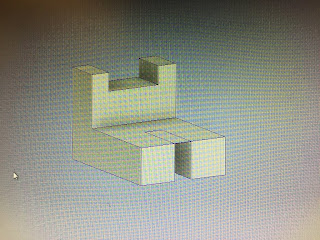Day 10
Intro to Engineering
Allen Sam
6-25-18
Activities 5.1, 5.2a, and 5.2b
Activity 5.1
Conclusion:
1. What is the difference between a circle and an ellipse?
2. What is the difference between an inscribed and a circumscribed shape?
3. Why is it impossible for a triangle to contain a 180° angle?
4. How is a rhombus similar to a square?
A rhombus and a square are similar because the have congruent side lengths but a rhombus can have different angles.
5. What is the difference between a right, acute, and obtuse triangle?
A right triangle is a triangle with a 90 degree angle, an acute triangle is a triangle with at least one angle under 90 degrees, and an obtuse triangle is a triangle that has one angle greater than 90 degrees.
5.2a
Conclusion:
1. What is a geometric constraint?
Geometric constraint is a constant, non-numerical relationship between the parts of a geometric figure
2. What are the different types of geometric constraints that are applied to sketches, and what are their functions?
A perpendicular constraint is a constraint that causes lines or axes of curves to meet at right angles.
A parallel constraint is two or more lines to be equidistant from each other.A tangent constraint is two arcs or a line an arc to intersect at a single pt perpendicular to the arcs radius. Coincident constraints fix two points together or fix a curve. Concentric constraints are two or more arcs or circles to share the same center pt.A Horizontal constraint causes lines to lie parallel to the X axis of the sketch. A co linear constraint is two lines or ellipse to lie along the same line.An Equal forces constraint is line segments to be the same length and arcs or circles to have the same radius. Vertical constraint causes lines to lie parallel to the Y axis of the sketch
A parallel constraint is two or more lines to be equidistant from each other.A tangent constraint is two arcs or a line an arc to intersect at a single pt perpendicular to the arcs radius. Coincident constraints fix two points together or fix a curve. Concentric constraints are two or more arcs or circles to share the same center pt.A Horizontal constraint causes lines to lie parallel to the X axis of the sketch. A co linear constraint is two lines or ellipse to lie along the same line.An Equal forces constraint is line segments to be the same length and arcs or circles to have the same radius. Vertical constraint causes lines to lie parallel to the Y axis of the sketch
3. Define “tangent”.
a tangent is a place where a point on a shape and another point on a line create perpendicular lines
a. Sketch a line tangent to two circles.
b. Sketch three circles such that all circles are tangent to the other two.
4. How is a geometric constraint different from a numeric constraint?
A numeric constraint is a number value or algebraic equation that is used to control the geometric figure. A geometric constraint is a non number value is used to control the relationship of the parts to the figure.
Activity 5.2b
Conclusion
1.
What advantages do CAD sketches have over
freehand sketches?
3.
Explain the difference between the Fillet sketch tool and the Fillet placed feature.
4.
The Fillet
placed feature is used to create both a “fillet” and a “round”. Describe the difference
between the two results.
5.
Could the
Shell feature be used to create the opening in the Automoblox body
passenger section (as in number 2 above)? Explain your answer.
The shell feature can be used to make an opening in the automoblox body passenger section if the right measurement is entered.
















Comments